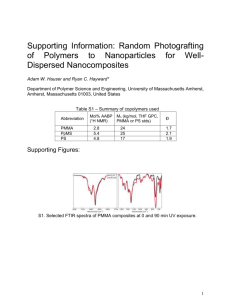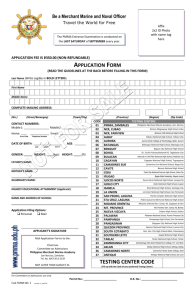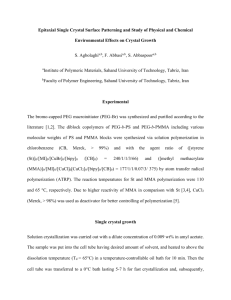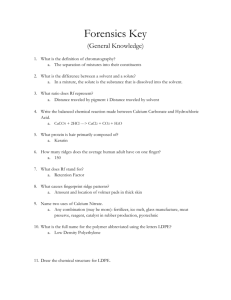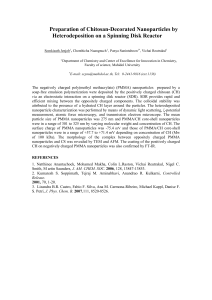pat3532-sup-0001-Supplementary
advertisement
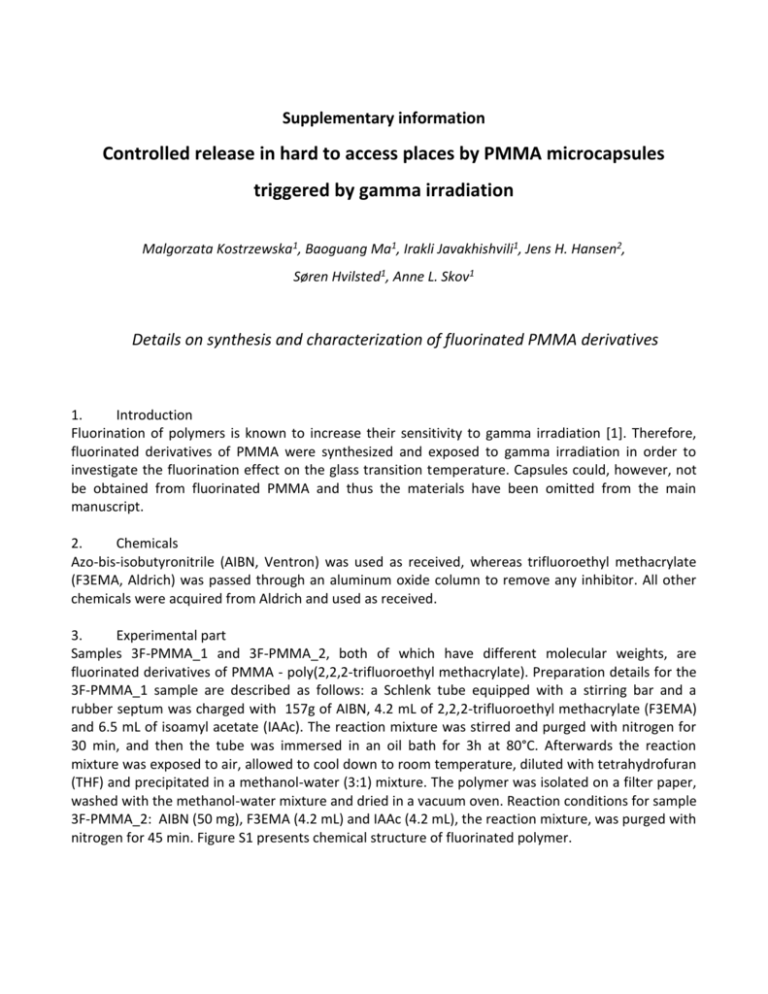
Supplementary information Controlled release in hard to access places by PMMA microcapsules triggered by gamma irradiation Malgorzata Kostrzewska1, Baoguang Ma1, Irakli Javakhishvili1, Jens H. Hansen2, Søren Hvilsted1, Anne L. Skov1 Details on synthesis and characterization of fluorinated PMMA derivatives 1. Introduction Fluorination of polymers is known to increase their sensitivity to gamma irradiation [1]. Therefore, fluorinated derivatives of PMMA were synthesized and exposed to gamma irradiation in order to investigate the fluorination effect on the glass transition temperature. Capsules could, however, not be obtained from fluorinated PMMA and thus the materials have been omitted from the main manuscript. 2. Chemicals Azo-bis-isobutyronitrile (AIBN, Ventron) was used as received, whereas trifluoroethyl methacrylate (F3EMA, Aldrich) was passed through an aluminum oxide column to remove any inhibitor. All other chemicals were acquired from Aldrich and used as received. 3. Experimental part Samples 3F-PMMA_1 and 3F-PMMA_2, both of which have different molecular weights, are fluorinated derivatives of PMMA - poly(2,2,2-trifluoroethyl methacrylate). Preparation details for the 3F-PMMA_1 sample are described as follows: a Schlenk tube equipped with a stirring bar and a rubber septum was charged with 157g of AIBN, 4.2 mL of 2,2,2-trifluoroethyl methacrylate (F3EMA) and 6.5 mL of isoamyl acetate (IAAc). The reaction mixture was stirred and purged with nitrogen for 30 min, and then the tube was immersed in an oil bath for 3h at 80°C. Afterwards the reaction mixture was exposed to air, allowed to cool down to room temperature, diluted with tetrahydrofuran (THF) and precipitated in a methanol-water (3:1) mixture. The polymer was isolated on a filter paper, washed with the methanol-water mixture and dried in a vacuum oven. Reaction conditions for sample 3F-PMMA_2: AIBN (50 mg), F3EMA (4.2 mL) and IAAc (4.2 mL), the reaction mixture, was purged with nitrogen for 45 min. Figure S1 presents chemical structure of fluorinated polymer. Figure S1. Chemical structure of 2,2,2-trifluoroethyl methacrylate. Irradiation process and analytical methods are reported in a main part of the paper. 4. Results and discussion In table S1 the results of gamma irradiation experiments are presented. The presence of fluorine atoms in a polymer’s structure did not clearly enhance chain scission during irradiation. Table S1. Glass transition temperatures and molecular weights of non-irradiated and irradiated polymers. Absorbed dose [kGy] 0 0.8 1.6 10 3F-PMMA_1 3F-PMMA_2 Mw Tg [°C] Mw [g/mol] Tg [°C] [g/mol] 10 000 22 000 62 71 PDI 2.5 PDI 2.1 62 63 49 74 47 74 On the one hand, the lowest Tg for the short-chain sample 3F-PMMA_1 was observed at a dose of 10 kGy, indicating that chain scission dominated over cross-linking even at higher doses in contrast to non-fluorinated PMMA. On the other hand, the Tg of sample 3F-PMMA_2 decreased at lower doses, but at 10 kGy the Tg was higher than initially, meaning that cross-linking took place with higher efficiency than in case of PMMA. In order to investigate changes in chemical structure of fluorinated polymer NMR method was used. Figure S2 presents spectra of irradiated sample 3F-PMMA_1. Since no new peaks were observed, it was assumed that gamma irradiation did not affect the structure of the polymer significantly. Therefore, there is no conclusive evidence that the fluorination process increase the sensitivity of PMMA to chain scission during gamma irradiation. Figure S2. 1H NMR spectra of 3F-PMMA_1 sample. Additionally, some attempts were made to prepare microcapsules with fluorinated PMMA shell. Fluorinated derivatives are highly hydrophobic and it caused significant changes in the oil phase. Since surface tension between the two phases changed agglomerations, lumps or microcapsules with acorn morphology formed [2]. Although various types and concentrations of surfactants were used for adjusting surface tension, the preparation of capsules with a fluorinated shell was not achieved. 5. Conclusions Fluorinated derivatives of PMMA with various molecular weights were synthesized. It was found that the presence of fluorine atom in a polymer chain does not influence the chain scission in an unambiguous way. Additionally, preparation of microcapsules with a fluorinated shell was not achieved due to high hydrophobicity of the polymer. Hereafter, it was concluded that fluorinated PMMA is not a good candidate a shell material for our purposes. References 1. Charles U. Pittman, Chi-Yu Chen, Mitsuru Ueda, J. N. Helbert, J. H. Kwiatkowski, J. Polym. Sci. A Polym. Chem., 1980, 18, 3413-3425 2. A. Loxley, B. Vincent, J. Colloid Interface Sci, 1998, 208, 49-62
